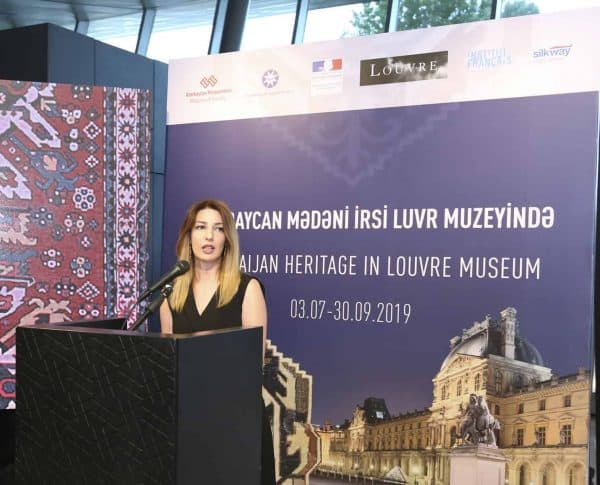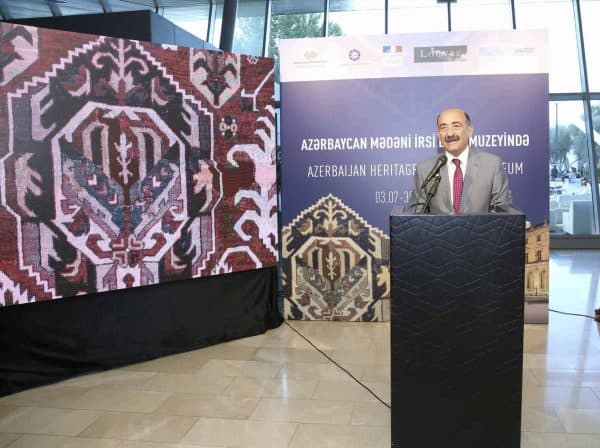2025
2025
2024-05-20

On 3 July – 30 September, 2019, the exhibition Azerbaijan Heritage in Louvre Museum was held at Azerbaijan Carpet Museum within the framework of the 43rd Session of the World Heritage Committee in Baku organized by the Ministry of Culture of the Republic of Azerbaijan, Azerbaijan Carpet Museum, Embassy of France in the Republic of Azerbaijan, Louvre Museum, French Institute in Azerbaijan, and Silk Way West Airlines. [1]
The Azerbaijani media reports on this occastion that “for the first time in our cultural history, three rare exhibits from the world-known Louvre Museum permanent exhibition will be presented”. According to Azerbaijani media, “this exhibition in Baku marked the beginning of cooperation between the two museums, which would strengthen these ties and serve as an impetus for large-scale projects representing samples of national heritage preserved in both art centers”. “This project is the Azerbaijan Carpet Museum's contribution to the implementation of the State Program for the Preservation and Development of Carpet Art in Azerbaijan for 2018–2022,” the announcement informs. [2]

The opening speech of the Minister of Culture of Azerbaijan in the Carpet Museum of Baku during the exhibition of carpets brought from the Louvre
From what has been said, it becomes clear how much importance is given to carpet art at the state level in Azerbaijan and what far-reaching goals they have concerning the carpets preserved in the collection of the Louvre Museum.
It should be noted that the three carpets, three rare items, seen in the photos covering the event, which Azerbaijanis proudly represents, are Armenian carpets. However, in response to objections from the Armenian side asserting that they are Armenian carpets, Vidadi Muradov, head of the carpet department at the Institute of Archeology and Ethnography of Azerbaijan, countered that they are Azerbaijani carpets and an integral part of Azerbaijan's history.[3]
"Azerbaijani carpets are as old as our history, ethnography and culture, and it is an undeniable fact that carpet weaving in the Caucasus is associated with the Azerbaijani people," Muradov said. According to him, Azerbaijani carpet weavers wove carpets according to patterns and ornaments related to their worldview, thinking and mythology.
Moreover, hes said, "Armenians' claims regarding Azerbaijani carpets, major and minor elements of which are of Turkic origin and are associated with symbols and signs used by the Turkic peoples, are simply absurd. I think that if there exists a tendency for mutual scientific, cultural, political, economic exchange in the world, then the Armenians should agree that they have made 'sufficient' use of this exchange throughout history and learned to weave carpets (and just to weave!) from Azerbaijani Turks, and should put an end to the search of such unreasonable Armenian symbols as the 'Armenian cross' or the like on Azerbaijani carpets,” he stated.[4]

The speech of the head of the Carpet Museum of Baku
The claim that Armenians learned the skills of carpet weaving from Azerbaijani Turks is simply absurd. The Armenian highlands are considered one of the oldest cradles of carpet weaving, with traditions that have continued for millennia without interruption.
Carpet-weaving tools, pieces of carpets and fabrics[5], as well as various spindles and heads of spindles excavated from many ancient sites in Armenia[6], serve as evidence of the spinning and carpet-weaving traditions in the Armenian highlands. Cuneiform, archaeological, and pictorial sources from the Urartian period contain remarkable data related to carpet-weaving culture and spinning in general. [7]
From the post-Urartian period, evidence of ancient spinning and carpet-weaving traditions dating from the 6th to the 4th centuries BC, has been discorvered during the excavations in Armenia. I. Karapetyan thoroughly discussed these findings in his work, noting that they testify to the existence of these traditions in the earlier period and their high level of development during that stage.[8]
The ancient origins of the ornaments on Armenian carpets have been discussed by both Armenian and foreign researchers. Their works pay special attention to the parallels with archaeological samples from the Bronze Age and Urartian iconography excavated in the territories of historical Armenia. In some cases, they also consider existing parallels with the iconography of ancient Asia Minor cultures. The opinions of both Armenian and foreign researchers are very important in this regard. For example, German carpet expert V. Gantzhorn, in his extensive study, specifically refers to the ancient origins of Armenian carpet decorative patterns.[9] In other words, the claim that Armenians learned the art of carpet weaving from Azerbaijanis is refuted by archaeological evidence, historical sources, testimonies, and facts.

The Armenian Jraberd carpet brought from the Louvre Museum and exhibiting it as Azerbaijani
As to the carpets from the Louvre Museum collection and exhibited in Baku, one of them is the famous Armenian Jraberd-type carpet, which various researchers consider a type of Armenian dragon carpet. According to Mania Ghazaryan, since the 17th century, Armenian classical dragon carpets began to lose their traditional appearance and were influenced by other contemporary carpets. This led to the emergence of several new types, including the aforementioned carpets, which were woven in the Armenian village of Jraberd in Artsakh, and later in the villages of Khndzoresk in Zangezur, Sisian, and other areas.[10]
Tatikyan considers this type of carpets as Eagle-carpets, Jraberd, or Khachen type, selecting one as the cover image for his seminal work "Dynastic Carpets of Artsakh." He regards these carpets as direct heirs to the Dragoncarpets, and their decorations, according to the scholar, are perfect and, probably, they have been originated from some well-preserved classical Dragon-carpet, and numerous details were taken from its decorations. [11] Such cross-like Eagle-carpet was found in the village of Garnaqar. [12] This type of carpets was studied and typologized by Ashkhunj Poghosyan who thinks that the Jraberd group of carpets should be divided into four sub-types, and among them to the classical Dragon-carpet are related those which are decorated with single ray-shaped composition, compiled through the surrounded from both sides intertwined dragons.[13]
Anyway, the fact is that Azerbaijanis reached a state-level agreement with the Louvre and presented the Armenian carpet samples stored there as Azerbaijani, showcasing them in Baku with great pomp.
[1] https://azcarpetmuseum.az/en/single/755 accessed 08. 05. 24.
[2] https://www.azernews.az/culture/153036.html accessed 08. 05. 24.
[3] https://anews.az/en/armenians-attempt-to-appropriate-azerbaijani-carpets-on-display-at-louvre-museum-photo/ accessed 09. 05. 24.
[4] https://en.trend.az/azerbaijan/politics/3088574.html accessed 10. 05. 24.
[5] See A. Poghosyan, On the question of the origin of carpet weaving in Armenia, PBH, 2, Yerevan, 2001, pp. 236-250.
[6] L. Yeganyan, Beyond Aragats : Archaeological students in memeory of Telemak Khachatryan, Yerevan, 2018, pp. 29-36.
[7] Y. Grekyan, New Evidence on Spinning in Urartu, Woman in the East, Yerevan, 2024, pp. 28-30.
[8] I. Karapetyan, Armenian material culture in VI-IV centuries BC., Yerevan, 2003, pp. 56-57.
[9] V. Gantzhorn, The Christian Oriental Carpet, Yerevan, 2013, pp. 48-56.
[10] M. Ghazaryan, pp. 11-12, im. 32, 36, 37, 40, 41.
[11] V. Tatikyan, Dynastic Carpets of Artsakh, Yerevan, 2004, 22.
[12] Tatikyan, p. 24:
[13] A. Poghosyan, Again about Dragon-carpets, New Ethnographic Journal, Yerevan, 2005, pp. 106-119.